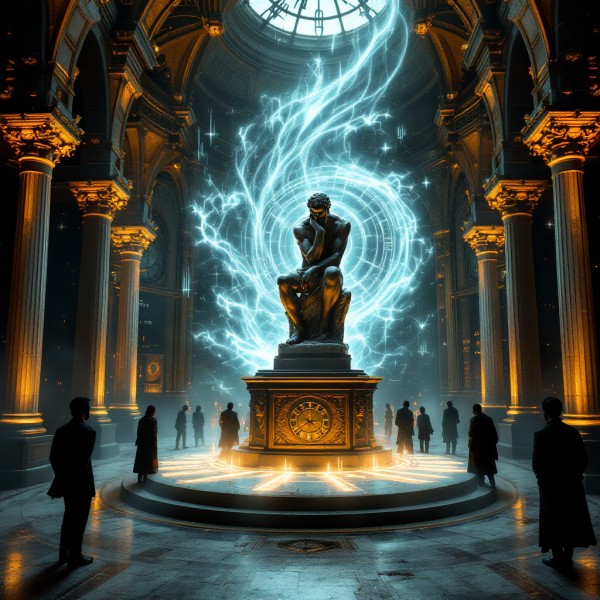April 2, 2025
The Art of Investing: Seizing the Cycle, Dominating the Game
Introduction
Markets are battlefields. Wealth is never handed over—it is seized. The investment cycle is not a gentle rhythm but a relentless tide that crushes the unprepared and elevates the cunning. It moves through four phases: boom, peak, collapse, and despair. Mastery demands more than mere observation; it requires anticipation, precision, and the will to act when others hesitate. The weak chase trends; the strong dictate them.
Deciphering the Investment Cycle
The economy breathes in expansion, euphoria, decline, and rebirth cycles. Every phase carries both peril and promise, but few possess the discipline to recognize the difference. Most investors drown in euphoria at the peak and cower in fear at the bottom. The shrewd see the cycle for what it is—a rigged game where knowledge, not luck, dictates survival.
To navigate this battlefield, we turn to those who have mastered its intricacies—men who have played the game at the highest level and emerged victorious. Their insights reveal how to identify bubbles before they burst, exploit downturns, and wield contrarian wisdom as a weapon.
Exposing the Mirage: The Art of Spotting Bubbles
Bubbles are not accidents but mirages built on greed and mass delusion. The foolish see infinite growth. The wise see a trap. When valuations lose touch with reality, speculation overrides fundamentals, and the mob cheers without question, a reckoning approaches.
The key to surviving bubbles is ruthless skepticism. The untrained eye sees a rocket; the strategist sees a grenade with a lit fuse. Ignore the herd. Focus on companies with unshakable foundations—those that thrive in any climate—fortresses, not castles of sand. If the crowd is euphoric, prepare to exit. If they scoff at value, prepare to enter.
Mastering the Fall: The Contrarian’s Edge
When chaos strikes, the herd panics. The streets are littered with abandoned stocks, discarded by those who lack the nerve to hold. This is where the elite step in. Fear-driven selling births the greatest opportunities. Crashes are not calamities for the prepared; they are invitations.
The contrarian thrives where others flee. They know crisis breeds bargains, and silence before the storm is the time to sharpen their blade. True diversification is not about following charts but about preparing for the cycles that the oblivious refuse to acknowledge. The economy will rise and fall, currencies will strengthen and collapse, and debt cycles will play their course. The question is not if, but when. The wise are already prepared.
Reading the Battlefield: Deciphering Price Action
Markets do not speak; they whisper. Only those trained in the language of price action can hear the truth beneath the noise. Candlestick patterns are not mere lines on a chart—they are psychological warfare unfolding in real time. They reveal fear, greed, hesitation, and deception.
The strategist does not guess—he deciphers. A Doji signals indecision, a Hammer exposes manipulation, and an Engulfing Pattern unveils a power shift. To the untrained, these patterns are random. To the master, they are battle signals.
The cunning do not rely on a single weapon. Candlestick charts must be wielded alongside moving averages, oscillators, and macroeconomic indicators. False signals lurk in volatile waters, and only fools act without confirmation. Precision is paramount. Those who misread the battlefield perish upon it.
Investment Cycle Titans: Mastering Market Highs and Lows
Recognizing the Illusion: The Dot-Com Bubble
During the dot-com boom, the masses drowned in euphoria, convinced that tech stocks were invincible. One man refused to drink the poison—he saw the mirage for what it was. Warren Buffett stood firm against the frenzy, avoiding the overhyped, profitless entities others worshipped. His refusal to buy into the illusion spared him from the devastation. When the dust settled, the landscape was littered with the corpses of once-glorified stocks. Buffett remained standing, his empire intact.
Turning Chaos into Profit: The 2008 Crisis
While others trembled, Ray Dalio sharpened his blade. As Lehman Brothers collapsed and investors ran for the exits, he stepped forward, buying when fear peaked. Treasury bonds, gold, commodities—each move is calculated, and each position is a statement. He exploited forced sales, acquiring distressed assets at a fraction of their worth.
Critics accused him of profiting from destruction. But to Dalio, crisis was not tragedy—it was inevitability. He did not cause the storm; he merely prepared for it. When the tide turned, he and his firm stood enriched while those who doubted him lay in ruin.
Unmasking the Turning Point: Candlestick Charts in 2020
In March 2020, when the pandemic-induced selloff shredded markets, the fearful saw only red. But those who understood price action saw a bullish hammer forming—a silent declaration that the collapse was approaching. Those who heeded the signal seized stocks at their lowest; those who ignored it watched from the sidelines as the market rebounded with ferocity.
Steve Nison’s candlestick charts did not predict the future; they unveiled the present ruthlessly. They exposed the stimulus-fueled reversals, the vaccine-driven surges, the cycles of fear and greed playing out in real time. Those who understood them adapted. Those who did not became victims of their ignorance.
Concluding Thoughts
The market is not a playground—it is a battlefield where hesitation bleeds you dry, ignorance is a death sentence, and fear is a leash that keeps the weak in servitude. Every cycle follows the same ruthless pattern: euphoria blinds the herd, excess breeds collapse, and despair sets the stage for the next empire. This is not speculation; it is historical fact.
The 1929 crash, the dot-com implosion, the 2008 financial meltdown, and the 2020 pandemic sell-off—each crisis lured in the gullible, shredded their fortunes, and handed the spoils to those who understood the cycle. The elite do not react to markets; they orchestrate them. They offload overpriced garbage onto the masses at the peak and scoop up bloodied assets when panic-driven selling grips the streets.
Consider the ones who walked away richer every time:
- Warren Buffett ignored the dot-com frenzy while the world threw money at worthless internet stocks. When the dust settled, firms with no revenue vanished, while his empire stood untouched.
- Ray Dalio called the 2008 collapse before it happened. While the masses were euphoric, he positioned himself for catastrophe, emerging with billions.
- Paul Tudor Jones anticipated the 1987 crash and shorted the market, making a 200% return in days while others lost their shirts.
- John Paulson saw the subprime disaster coming and bet against the housing market, pocketing over $4 billion as Wall Street burned.
This is not luck. This is war. This is strategy.
Every crash transfers wealth from the unprepared to the informed. Every bull run ends with bag holders clinging to dreams while insiders cash out. The charts do not lie. Price action is a language, and those who cannot read it are blind. Candlestick reversals, volume shifts, liquidity traps—these are not academic theories; they are the real-time footprints of market manipulation.
The herd sees hope. The strategist sees deception.
Booms are engineered to lure in buyers before the rug is pulled. Crashes are manufactured to force panic-selling so that assets can be scooped up for pennies on the dollar. Governments step in too late, the Fed reacts after the damage is done, and the media fuels every hysteria phase.
The only way to survive—no, thrive—is to command the cycle, not be a victim of it. Identify the traps before they spring. Spot the reversals before they explode. Position yourself where the money is going, not where it has already been. The winners are not those who follow the rules—they are the ones who write them.
Wealth is not given. It is taken—by those who know when to strike, when to wait, and when to walk away with everything.











